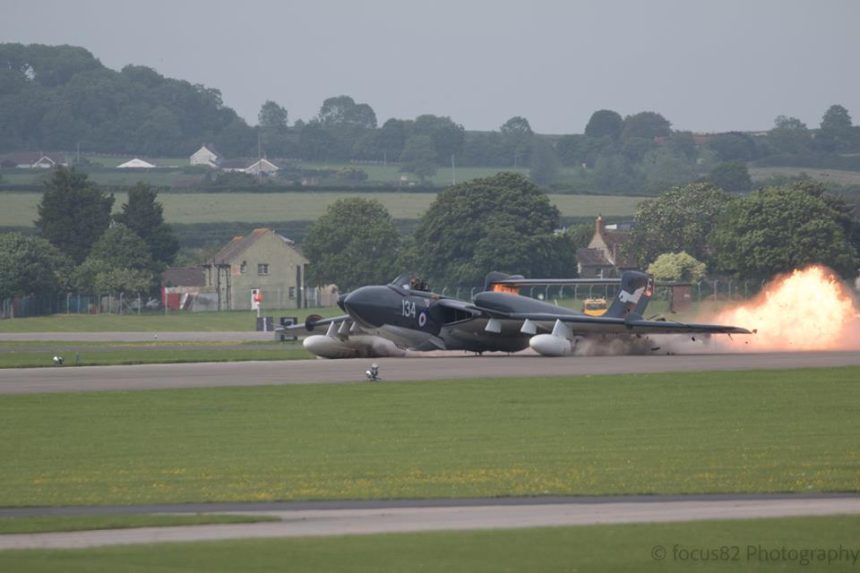Pilot Uninjured After Excellent Airmanship during Belly-Landing.
The last remaining Sea Vixen aircraft, XP924 G-CVIX “Foxy Lady”, has made an emergency landing without landing gear at Yeovilton, UK, on May 27.
The pilot was uninjured and walked away from the aircraft after jettisoning the canopy upon touchdown on the tarmac.
Mr. Scott Dabinett, 32, of Yeovil, Somerset, UK captured excellent photos of the incident. Here is his account of the incident:
“As always when I have the chance to photograph aircraft I made arrangements with the wife to visit Yeovilton airfield. I arrived early and set up the camera equipment.
Due to possible weather issues the display time had been brought forward and the aircraft would be leaving at 1615. It took off on time as planned. We waited the hour and ten minutes for the flight as planned. A chap had a handheld scanner so we could hear what was going on.
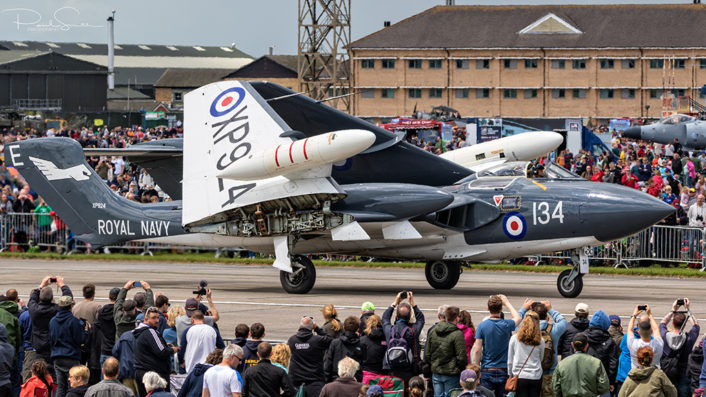
The aircraft returned from Duxford and flew up the runway. We then heard radio communications between the tower and the pilot asking for visual of the landing gear. The response was your undercarriage is clean, which means it is still up. After several more passes and discussion between pilot and tower and other emergency personnel, it was soon announced that this was going to be a gear-up belly landing.
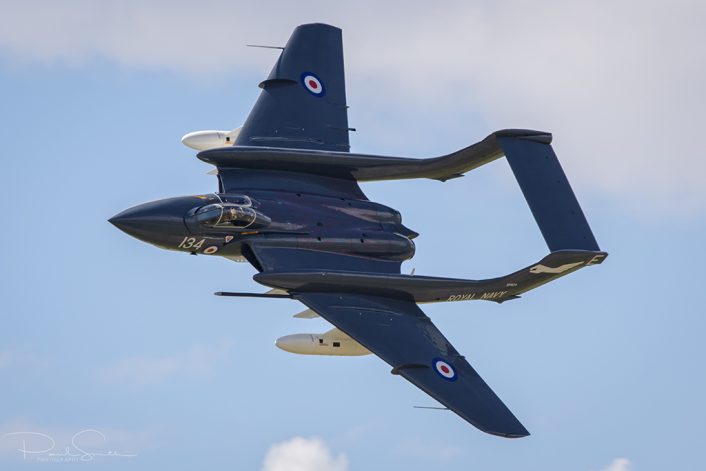
The feeling between the few of us standing by was that this does not look good. On the final approach we all crossed our fingers and held our breaths whilst pointing our cameras at the Sea Vixen.
As soon as she touched the runway the canopy was released and engines were shut down. She slid up the runway very smoothly and under control. It was much quieter than I was expecting. Eventually she came to a stop. We kept waiting for movement from the pilot.
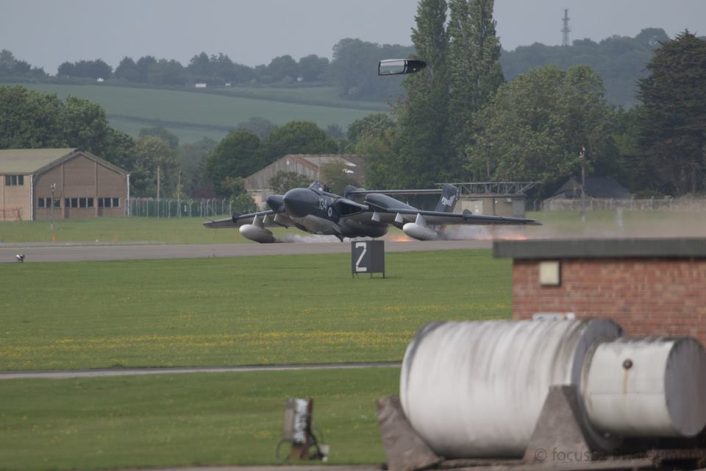
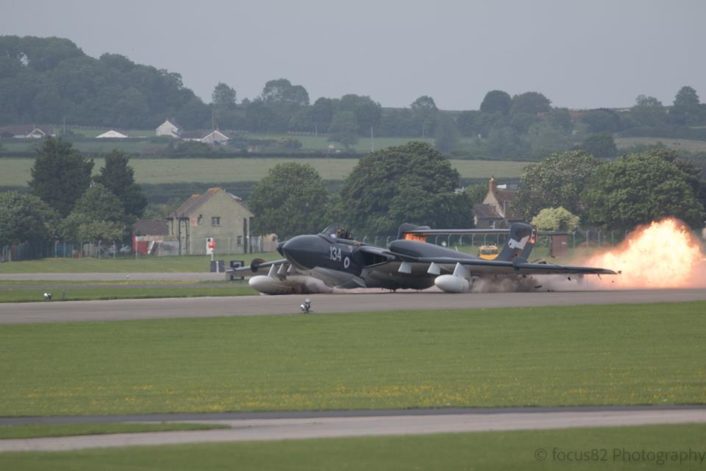
As soon as we saw the pilot was OK we all started breathing again. Everyone was shaking. The emergency guys were on the scene straight away and took control of the situation. I would like to ask people to visit the navy wings website and make donations if possible as it will help repair aircraft like this that otherwise will be lost for good.”
[Editor’s Note: The aircraft is kept flying largely through private donations to the Navy Wings site at this link: https://www.navywings.org.uk/support-us/sea-vixen-appeal-2017/]
This incident might have been caused by a hydraulic problem that prevented extending the landing gear. Interestingly, a similar incident occurred 46 years ago on Sept. 15, 1970 at RNAS Yeovilton, Somerset in the UK when Sea Vixen XJ561 performed an emergency landing without landing gear. That aircraft was written off and subsequently scrapped in 1974.
The incident is somehow alarming in the wake of an unusually high number of airshow accidents early last airshow season in 2016. In June last year there were four serious airshow accidents around the world in only one week. The accidents involved the U.S. Navy Blue Angels who suffered the loss of Marine Capt. Jeff Kuss, the U.S. Air Force Thunderbirds that lost an F-16 aircraft, the Russian Knights aerobatic team that also suffered a fatality and the Swiss demonstration team, Patrouille Suisse that had two aircraft involved in a collision.
Airshow incidents are of particular concern in the UK because of the August 2015 crash of a Hawker Hunter T7 at Shoreham Airshow, Shoreham Airport. There were 11 fatalities from the crash on the ground and 16 injuries. It was the deadliest airshow accident in the United Kingdom since a 1952 crash at the Farnborough Air Show that killed 31 people. Oddly, the show in 1952 continued the next day following the deadly accident.
Sea Vixen XP924 “Foxy Lady” is operated by Fly Navy Heritage Trust Navy Wings. According to information published on the Navy Wings web page:
“Sea Vixen XP 924 first flew on September 23, 1963 and was delivered to 899 Squadron at RNAS Yeovilton on December 18, 1963. The aircraft suffered several incidents in squadron service. Tyre bursts, canopy shattering, some engine problems and, while onboard HMS Eagle, an inadvertent release of a practice bomb near the island of Gan in the Indian Ocean. Retirement from active service sent her to Royal Naval Aircraft Yard at Belfast in August 1971. The Royal Aircraft Establishments (RAE) at Farnborough and Llanbedr were in possession from 4 June 1973 until August 1977. Flight Refuelling took over on 11 October 1977 at Tarrant Rushton and converted her to a Drone (D3) with a Red and Yellow paint scheme to improve visual acuity. In February 1996 she was taken on by de Havilland Aviation and was re-registered as G-CVIX. In May 2003 she was painted in promotional “Red Bull” colours as a sponsorship arrangement and was subsequently purchased on 18 April 2006 by Drilling Systems Ltd (Mr. Julian Jones) and operated from Bournemouth. March 2007 saw a return to Naval colours as XP 924 with the 899 Squadron mailed fist logo. The aircraft was gifted to Naval Aviation Ltd in September 2014 and now operates from the Royal Naval Air Station Yeovilton.”
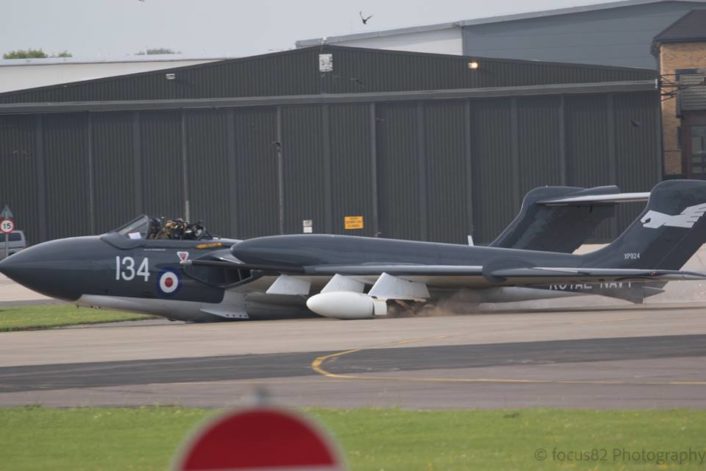
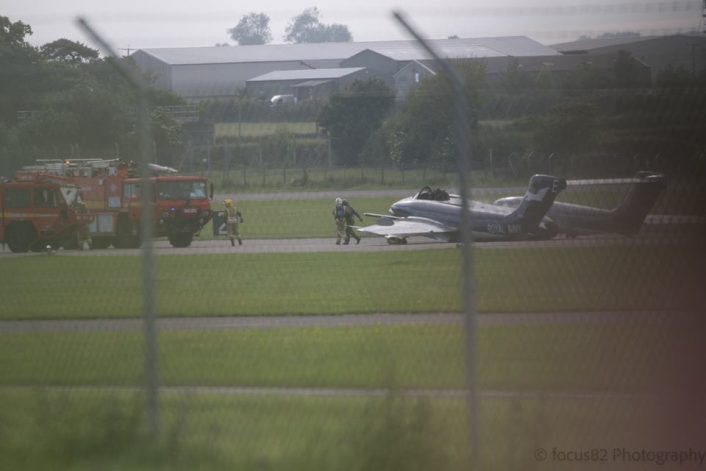
The Sea Vixen is an unusually configured aircraft that first flew in 1951. It was the first British two-seat aircraft to break the sound barrier when it achieved Mach speed in a dive during its operational testing phase in the early 1950’s. It was replaced by the F-4 Phantom in British service.

